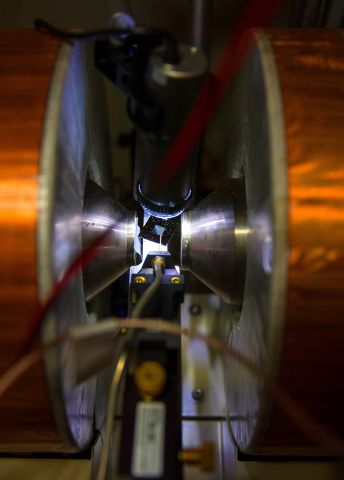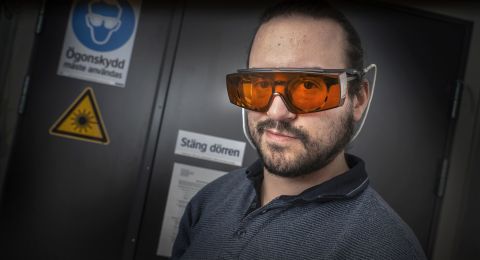
Project Grant 2015
Harnessing light and spins through plasmons at the nanoscale
Principal investigator:
Alexander Dmitriev, Professor of Physics
Co-investigators:
Dag Hanstorp
Johan Åkerman
Uppsala University
Björgvin Hjörvarsson
Peter Oppeneer
Vassilios Kapaklis
Institution:
University of Gothenburg
Grant in SEK:
SEK 38 million over five years
If you point a magnet at a metal object, the object, or the magnet, may move. A magnet can also change the direction of an electric current – a stream of electrons. But if you point a magnet at light, nothing happens at all. Light and magnetism do not interact.
They ought to be able to interact, since light is electromagnetic radiation, and all such radiation consists of oscillating magnetic fields. But the reason that light and magnetism do not recognize one another is that light has a so much higher frequency – it oscillates 10,000 times faster than the fastest magnetic fields.
“Photons, that is, particles of light, can be absorbed. And when they pass through a transparent material, they can slow down and change direction, but only in one way, specific to the material. To make them steerable in real time is a whole different story,” says Alexander Dmitriev.
He works at University of Gothenburg’s Department of Physics, and is heading a project funded by the Knut and Alice Wallenberg Foundation, bringing together researchers from Gothenburg and Uppsala. They appear to have found a way to couple light to magnetism.
Plasmons couple light to magnetic fields
The researchers are making minute “antennas”, tiny nanoscale rods, discs and balls, only billionths of a meter across. The antennas are attached to a transparent surface such as glass. When light strikes the antennas, it causes the electrons in them to oscillate. And unlike magnetic fields, electrons can actually oscillate almost as fast as light. When they do so, nanoplasmons are created. These may be described as a cross between an electron and a photon. They produce a concentrated, amplified and rapidly oscillating nanoscale electromagnetic field. This is what bridges the gap between light and magnetism. The plasmon can be influenced by magnets, so that the photon emerges in a changed state. The light may take a different direction or acquire a different polarization, for example.
“We modify the plasmon rather than the photon. The plasmon is then transformed back into a photon, and that is the magic of it. Some energy is lost, but the better we do our job when we build the nanoantennas, the more photons survive,” explains Alexander Dmitriev.
The antennas are made of metals such as gold, silver, copper and aluminum. By their choice of materials, together with the shape of the antennas, the researchers can control what happens to the nanoplasmons.
Steerable lenses and lightning-fast data storage
Fantastic opportunities will open up if the method works as intended. For instance, a conventional camera needs several lenses to do what our eyes are capable of all on their own. The eye needs only one lens, since it can change shape when it needs to refract and focus light differently. The new technique could achieve the same light steering using an artificial flat lens.
“So we believe it may be possible to make optical elements that can be changed in real time,” Dmitriev comments.
If so, camera optics could be completely flat, instead of having a long, heavy housing for a series of lenses. It would also be possible to make moving holograms, and much better augmented reality glasses and transparent computer screens. It is not technically difficult to create the required miniature magnetic fields for steering; this can be done in something as small as an average cellphone.
But the researchers also want to find out how things work in the opposite direction, i.e. whether magnetic fields can be controlled by light. The point of this is that magnetism is used to store information on hard disks, and is currently controlled electrically. If magnetic fields could be controlled using light, the process would be much quicker, and the read-write time would be thousands of times faster.
“If it works, it may become possible to develop completely new information storage technology,” Dmitriev says.
Cross-border collaboration needed
Nanoplasmons appear to offer a practical solution to numerous problems. Yet still few researchers across the world are studying the link between nanoplasmons and magnetism. Dmitriev thinks this is because the field has a rather focused interest.
“The truth is that there is fairly little contact between different research fields. Researchers who are experts in magnetism are not particularly interested in plasmonics or nano-optics. Someone who knows nano-optics sees little connection to magnetism. In this case, I happened to have some insight in both fields, and the project has brought together members who normally would not be working together.”
A particularly important aspect of the project is that experimental and theoretical scientists are collaborating. As far back as 20 years ago researchers showed that short, intense pulses of light could affect the field on a magnetic film. But no-one has fully explained yet how this works. This is not good enough, as Dmitriev explains:
“We don’t just want to make things and be happy if they work. We want to gain a deeper understanding of the process. After all, this is basic research – although it isn’t hard to see future practical applications.”
Text Lisa Kirsebom
Translation Maxwell Arding
Photo Magnus Bergström





